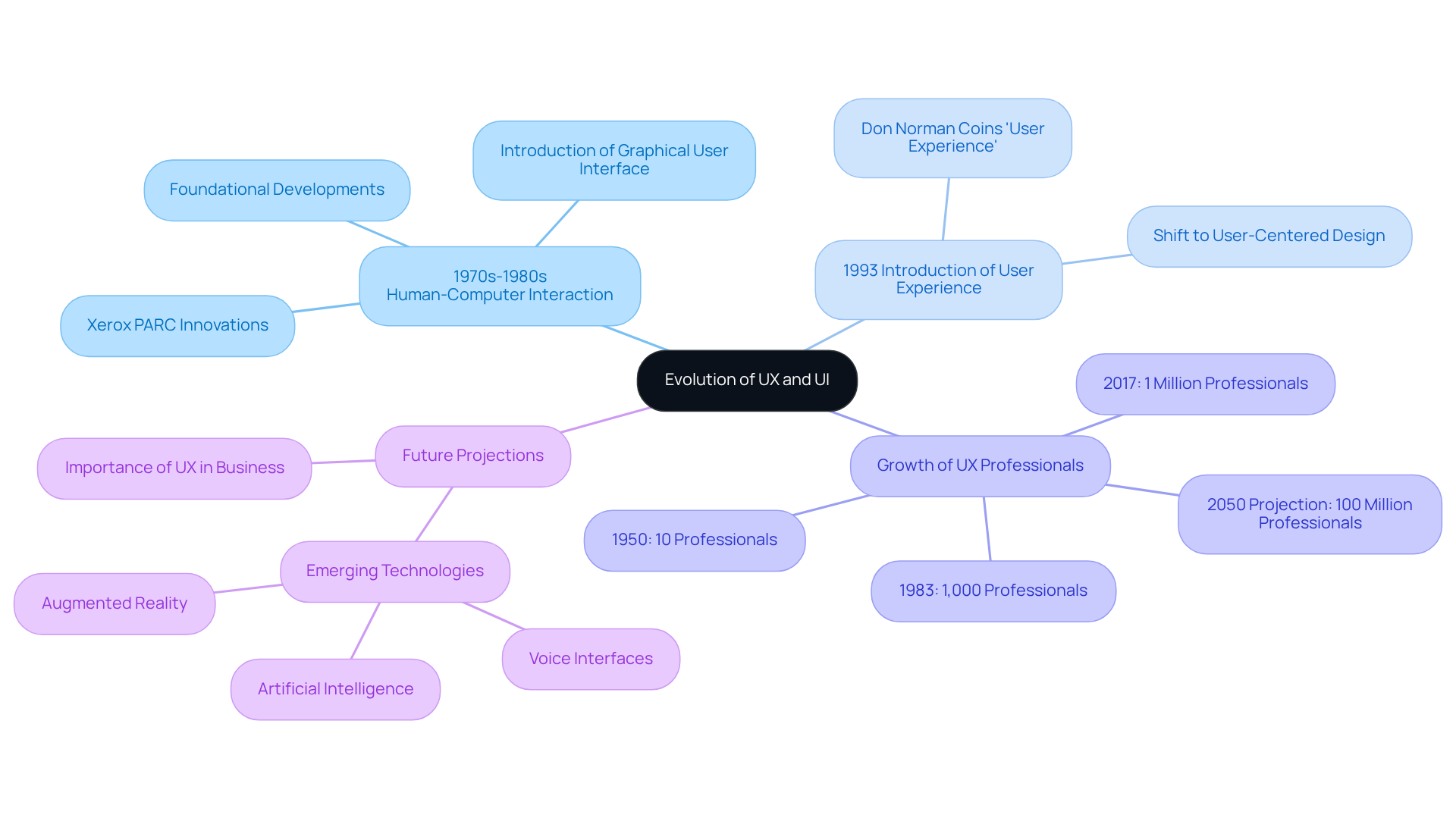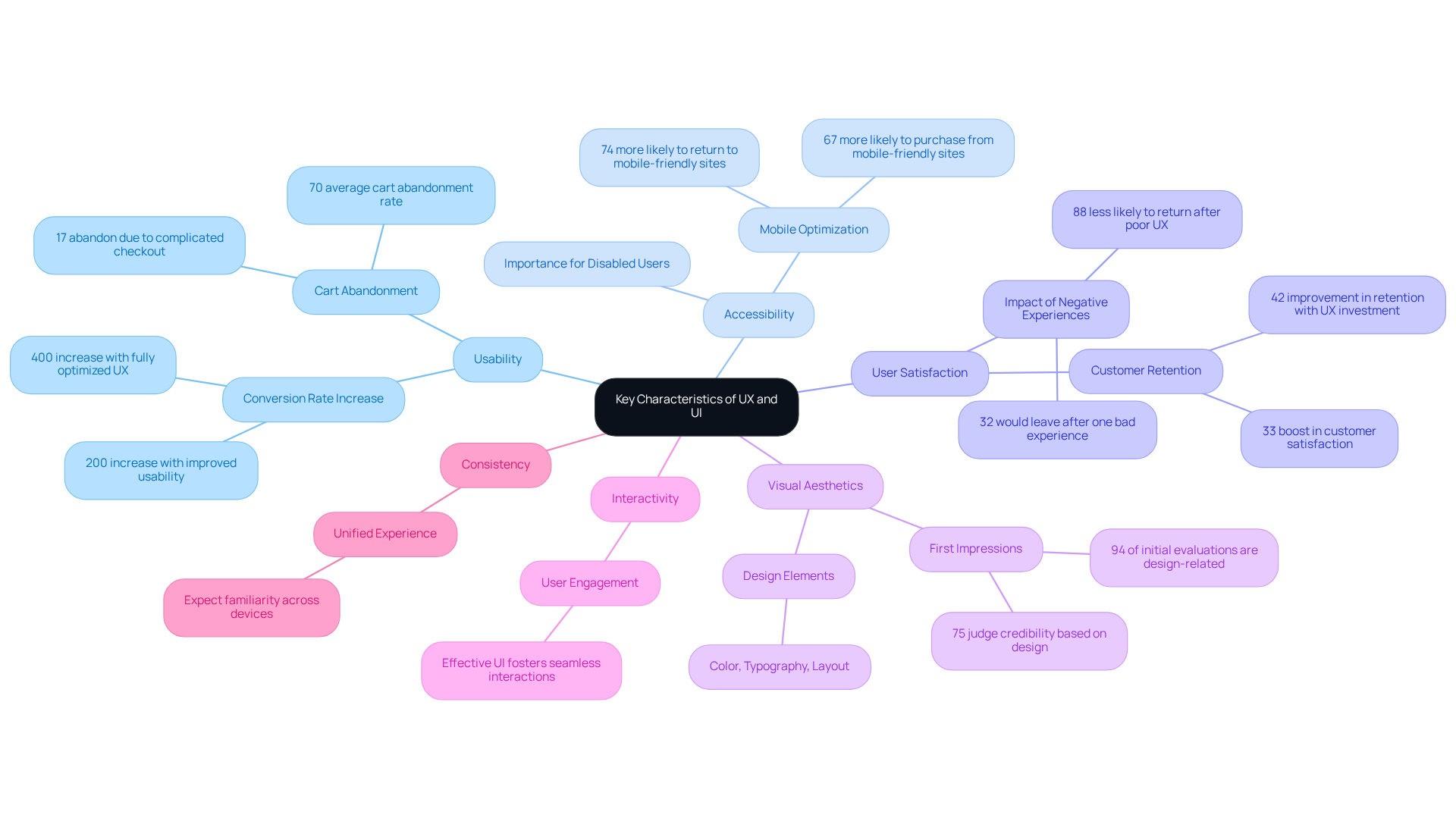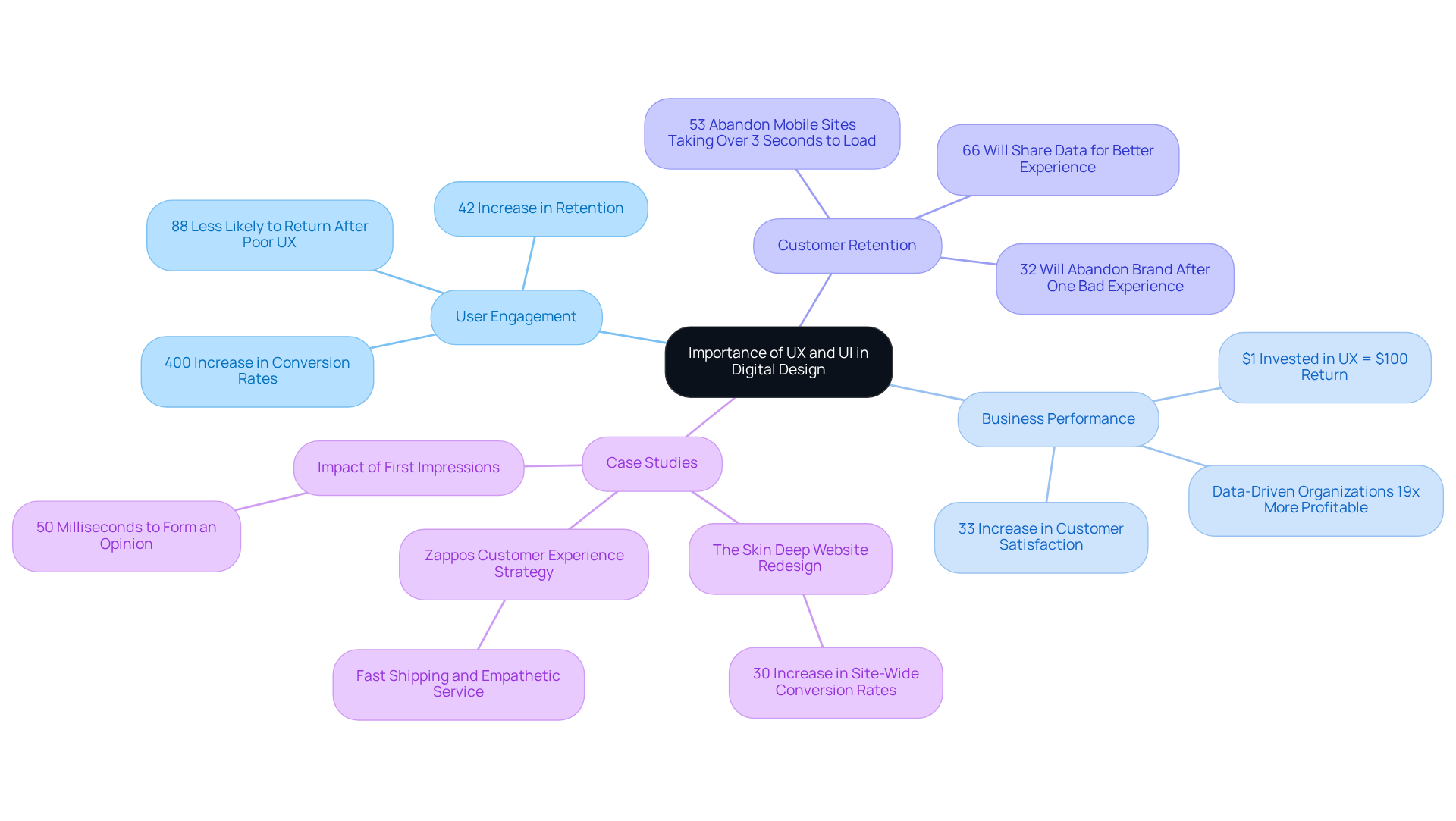Overview
This article delves into the meanings and distinctions between User Experience (UX) and User Interface (UI), recognizing the challenges many tech startup founders face in navigating these concepts. It highlights the critical roles both play in digital design and user satisfaction, acknowledging that without a clear understanding, businesses may struggle to connect with their users effectively. The implications of this disconnect can be significant, leading to lower conversion rates and decreased customer retention.
However, by illustrating how the effective integration of UX and UI can pave the way for meaningful business advantages, such as fostering loyalty and enhancing user engagement, we emphasize the necessity of prioritizing user-centered design in today's competitive market. Together, we can embrace a design philosophy that nurtures users and ultimately drives success.
Introduction
In today's digital landscape, understanding the nuances of User Experience (UX) and User Interface (UI) is more than just beneficial; it's essential. User interactions can truly make or break a brand, and as technology evolves, the distinction between these two concepts becomes increasingly significant. This distinction impacts not only usability but also accessibility and overall satisfaction. Yet, many businesses grapple with a pressing question: how can they effectively harness the power of both UX and UI? It’s not just about attracting users; it’s about fostering lasting engagement and loyalty.
Consider the frustration of a user who struggles to navigate a poorly designed interface. This experience can lead to dissatisfaction, and ultimately, a loss of trust in a brand. It’s a painful reality that many tech startup founders face. But there is hope. By prioritizing both UX and UI, businesses can create a seamless experience that resonates with users on a deeper level.
At RNO1, we understand these challenges intimately. We believe in nurturing the relationship between users and brands through thoughtful design. Our approach focuses on creating experiences that not only attract users but also invite them to return time and again. Together, we can transform the way users interact with your brand, ensuring their journey is as rewarding as it is engaging.
Define UX and UI: Core Concepts and Distinctions
The UX and UI meaning is a vital aspect of how individuals interact with an item, focusing on usability, accessibility, and emotional engagement. It’s about crafting a journey that resonates with users, ensuring their needs and expectations are met throughout their interaction. On the other hand, User Interface (UI) zeroes in on the visual and interactive components, such as buttons, icons, and layout, which are essential to understanding the UX and UI meaning by shaping the perception and navigation of the item. The distinction between UX and UI meaning is that while UX prioritizes overall satisfaction and experience, UI emphasizes the aesthetic and functional aspects of the layout.
Recognizing these differences is essential for developing effective digital products, as it helps clarify UX and UI meaning. Many tech startup founders face the challenge of standing out in a crowded market. Recent trends in 2025 highlight that good design is crucial for differentiation in the competitive software industry, as noted by Yun Jong Yong. It’s concerning to realize that 88% of online consumers are less likely to return to a site after a negative experience. This statistic underscores the pressing need for seamless UX.
Successful digital initiatives reveal that integrating both UX and UI, along with the UX and UI meaning, leads to enhanced satisfaction and engagement. For example, brands that prioritize comprehensive UX strategies often see a 30% increase in conversion rates. This illustrates that while UI captures attention, it’s the UX that fosters engagement and builds loyalty. Therefore, a balanced focus on both the UX and UI meaning is essential for creating products that not only attract users but also offer meaningful and enjoyable experiences. Together, we can that nurtures user connections and fosters lasting engagement.

Explore the Evolution of UX and UI: Historical Context and Development
The evolution of User Experience (UX) and User Interface (UI) creation demonstrates the UX and UI meaning, reflecting a journey that started with the foundational developments in human-computer interaction during the 1970s and 1980s. The term 'User Experience,' introduced by Don Norman in 1993 while he was at Apple, marks a pivotal moment that underscores the significance of a user-centered approach. This shift arose from the growing complexity of technology, which often left users feeling overwhelmed and in need of more . As the internet and mobile devices gained prominence, the focus of design shifted towards creating engaging and accessible interfaces that cater to diverse individual needs.
The remarkable growth of the UX profession is a testament to this shift, expanding from about 10 professionals in 1950 to approximately 1,000 in 1983, and then soaring to an estimated 1 million by 2017. Looking ahead, projections indicate that by 2050, around 100 million individuals will be involved in UX roles worldwide. This exponential growth highlights the crucial role of client experience in product creation and service delivery. Companies increasingly recognize that effective UX can significantly enhance customer satisfaction and loyalty, addressing the emotional connection between users and products.
In today’s rapidly evolving landscape, the UX and UI meaning is crucial as their creation continually adapts to emerging technologies such as voice interfaces, augmented reality, and artificial intelligence. These advancements mirror the changing expectations of individuals, who seek seamless and engaging interactions across various platforms. For instance, case studies like the one involving Staples, which experienced a 500% increase in online revenue following UX-focused redesigns, vividly illustrate the tangible benefits of investing in user-centered design. This serves as a powerful reminder of how prioritizing UX can drive business success.
As we look to the future, it is essential to incorporate UX principles into every aspect of development. This commitment ensures that the needs of individuals remain at the forefront of innovation in our increasingly digital environment. By embracing a user-centered approach, we can foster a more compassionate and effective technological landscape, ultimately enhancing the experiences of everyone involved.

Analyze Key Characteristics of UX and UI: Components and Functions
Key characteristics of user experience (UX), along with the UX and UI meaning, encompass usability, accessibility, and user satisfaction, all of which are crucial for fostering a positive interaction with digital products. Imagine the frustration of navigating a poorly designed interface; usability ensures that items are intuitive and simple to navigate. This is essential, as poor usability can lead to significant revenue losses. For instance, enhancing website usability can increase conversion rates by as much as 200%, while a fully optimized user experience can elevate conversion rates up to 400%. Accessibility emphasizes the importance of making products functional for individuals with disabilities, ensuring that everyone can participate in the digital world. User satisfaction, assessed through feedback and testing, reveals a startling statistic: 32% of customers would abandon a brand after just one negative experience. This underscores the importance of consistently delivering quality experiences. It’s estimated that poor UX costs businesses a staggering $1.4 trillion annually, highlighting the urgent need to address these challenges.
When we explore the UX and UI meaning, we find important traits like , interactivity, and consistency. Visual aesthetics include elements such as color, typography, and layout, which together shape first impressions. In fact, 94% of initial evaluations of a website are tied to its visual aspects, and 75% of individuals judge a company's credibility based on its website's appearance. Interactivity relates to how users engage with the interface; effective UI design fosters seamless interactions that enhance satisfaction. Consistency across different screens and devices is vital for creating a unified experience, as users naturally expect familiarity in their interactions. Collectively, these traits lay the groundwork for effective digital creation, nurturing engagement and retention in an increasingly competitive landscape. Good UX has a direct, proven impact on ROI, making it essential for businesses striving for success. By prioritizing these elements, we can create a supportive environment that not only meets user needs but also drives business growth.

Understand the Importance of UX and UI in Digital Design: Enhancing User Engagement
The importance of understanding UX and UI meaning in digital creation cannot be overstated. A thoughtfully crafted user interface not only makes interactions intuitive but also enhances the overall user experience, fostering enjoyment and satisfaction. Many of us have faced frustration when navigating poorly designed platforms, and it's crucial to recognize the implications of these experiences.
Studies reveal that firms prioritizing user experience can achieve conversion rates that soar by as much as 400%. This statistic underscores the vital link between effective aesthetics and business performance. Furthermore, for every $1 invested in UX design, there is a remarkable return of $100, showcasing the financial advantages of investing in UX and UI. Companies that improve customer satisfaction often report a 42% increase in retention and a 33% rise in contentment.
As Ramziya Muhammed wisely notes, 'User interaction significantly influences customer loyalty, brand reputation, and business success.' In today's competitive online landscape, where 88% of individuals are less likely to return after a negative interaction, it becomes essential for brands to differentiate themselves through outstanding aesthetics.
Consider The Skin Deep, which revamped their website and experienced a 30% increase in site-wide conversion rates. Moreover, with over half of consumers willing to switch brands after a poor user experience, the stakes are indeed high. Thus, is not just beneficial; understanding the UX and UI meaning is essential for sustainable growth and nurturing customer loyalty. Together, we can create experiences that not only satisfy but also resonate deeply with users.

Conclusion
Understanding the meaning of UX and UI is not just important; it's essential for creating digital products that truly resonate with users. Many founders face the challenge of ensuring that their products connect emotionally with their audience. While User Experience (UX) emphasizes overall satisfaction and emotional ties, User Interface (UI) focuses on the visual and interactive elements that enhance this experience. Finding the right balance between these two aspects is crucial, as it not only enhances usability but also fosters user loyalty and engagement. This balance is vital for businesses striving for success in a competitive landscape.
Throughout this article, we’ve explored the distinctions between UX and UI, shedding light on their unique contributions to digital design. It’s clear that understanding these elements can significantly impact your journey. The historical evolution of these concepts, the characteristics that define effective UX and UI, and the tangible benefits of prioritizing user-centered design are all key insights that resonate deeply. Statistics reveal the substantial impact that good UX has on conversion rates and customer retention, reinforcing the notion that investing in these areas is not merely beneficial but essential for sustainable growth.
Ultimately, the significance of UX and UI in digital design transcends aesthetics; it’s about crafting meaningful and enjoyable user experiences. As technology continues to evolve, embracing a user-centered approach will empower you to meet the changing needs of your audience. By prioritizing UX and UI, you can cultivate deeper connections with your users, driving engagement and nurturing long-term loyalty. The call to action is clear: invest in understanding and implementing effective UX and UI strategies to not only meet user expectations but to exceed them. Together, let’s pave the way for future success.
Frequently Asked Questions
What do UX and UI stand for?
UX stands for User Experience, while UI stands for User Interface.
What is the primary focus of User Experience (UX)?
The primary focus of UX is on usability, accessibility, and emotional engagement, ensuring that users' needs and expectations are met throughout their interaction with a product.
What does User Interface (UI) emphasize?
UI emphasizes the visual and interactive components of a product, such as buttons, icons, and layout, which shape the perception and navigation of the item.
How do UX and UI differ?
While UX prioritizes overall satisfaction and experience, UI focuses on the aesthetic and functional aspects of the layout.
Why is understanding the distinction between UX and UI important?
Understanding the distinction is essential for developing effective digital products, as it clarifies the roles of UX and UI in creating user-friendly experiences.
What recent trends highlight the importance of good design in the tech industry?
Recent trends in 2025 indicate that good design is crucial for differentiation in the competitive software industry, as many tech startup founders struggle to stand out.
What impact does a negative user experience have on online consumers?
According to statistics, 88% of online consumers are less likely to return to a site after a negative experience, highlighting the need for seamless UX.
How can integrating UX and UI benefit digital initiatives?
Successful digital initiatives that integrate both UX and UI often lead to enhanced satisfaction and engagement, with brands prioritizing UX strategies seeing up to a 30% increase in conversion rates.
What is the overall goal of balancing UX and UI in product design?
The goal is to create products that not only attract users through appealing UI but also provide meaningful and enjoyable experiences through effective UX, fostering user connections and lasting engagement.




